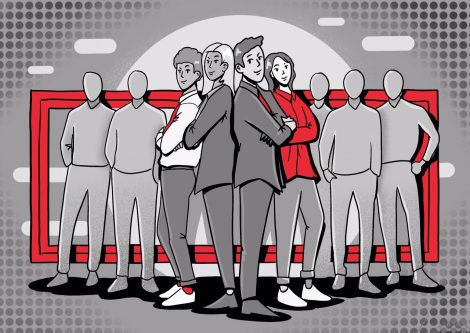Shared leadership is (not) good for the team result

Who’s the boss here, anyway? Who makes the decisions? Don’t many cooks spoil the broth? And how efficient can this be if management tasks are taken on by different team members? What is it about “shared leadership”?
Times are more difficult than ever for managers – an increasingly complex environment, demanding employees asking for more responsibility and yearning for purpose. And above all there is this constant pressure for change and a never-ending number of new projects. The traditional allocation of roles – the boss giving direction, providing sense, knowing the issues and topics and the team dealing with the tasks – is increasingly reaching its limits. The result are overburdened managers and frustration in the teams. As a response, we are increasingly observing new leadership models such as “Shared Leadership” in practice.
One function – several heads
What is this – shared leadership? Professor of psychology J. Moskaliuk describes Shared Leadership in such a way that the tasks that used to be the sole responsibility of the manager are now allocated to different members in the team. This can but does not have to be necessarily a classic job sharing model of a management position. The concept goes much further: leadership responsibilities are taken on or given up by changing team players depending on the requirements. The team makes decisions together and takes responsibility for the results. The manager is primarily there to inspire, motivate and coordinate diversity within the team.
That sounds attractive, modern and fashionable – but is it also good for the team result? Is this not inefficient and confusing? And what conditions must be in place to ensure that this model of leadership does not end up in chaos and once again stress?
In a recent meta-study, Wu, Cormican and Che (2020) investigated the causal relationships between the requirements for Shared Leadership, the moderations and the team result. Their analysis of 40 studies on the topic clearly shows: yes, teams with Shared Leadership can enjoy improved team results! According to the levels of Pearce and Conger (2003) the results improve in four dimensions: group behavior processes, attitudinal outcomes, team cognition, and team performance. Teams work more network-oriented, show better problem-solving skills, team members feel greater satisfaction and achieve higher efficiency and effectiveness. Overall, this is also reflected in an increased measurable performance (e.g. improved sales figures).
So Shared Leadership is THE solution for all team worries?
To pour some cold water on this matter, not for all leadership and team difficulties and challenges, Shared Leadership is the solution. To be able to enjoy improved team results, certain prerequisites are necessary:
The team should see a common purpose in their work, have a collegial, trusting relationship with each other beforehand and feel encouraged to participate and have a say. In addition, the team should be heterogeneously staffed and have tasks with mutual dependencies and connections.
In other words, if there is a high level of frustration, an elbow culture, exaggerated hierarchical thinking and overall little team spirit, according to the research findings of Wu/Cormica/Chen (2020), the introduction of Shared Leadership will not be effective. As a purely “modern” leadership method, the allegedly well-intentioned – and perhaps externally driven – project to implement Shared Leadership might even lead to greater uncertainty and ultimately failure.
Other research shows that the previously dominant leadership culture has a strong influence on the effectiveness and efficiency of Shared Leadership – the more transformational the leadership was previously, the better the result (D., Waldman, D. A., & Zhang, Z. (2014)).
Investment in team and leadership development pays off
If you like, Shared Leadership is a consequent next step following up to successful team development towards high performing teams. What is needed is a diverse, real team with a common goal, a meaningful, coherent task allocation, trust and open-mindedness. Then a modern leadership concept such as Shared Leadership can make a lot of sense and will not have the appeal of a meaningless innovation exercise without effect and with high potential for chaos.
It might be a bumpy road with investments in team and cultural development as well as organizational adjustments, however, a worthwhile goal awaits: an improved measurable team result. This naturally has a positive effect on motivation in the team leading to an increased enjoyment of the work – for all those involved, including the manager.
Sources:

